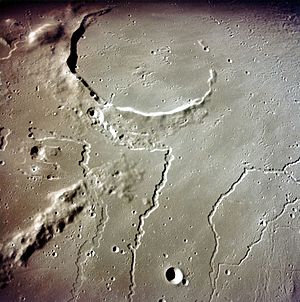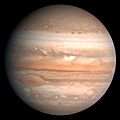Planetary science facts for kids
Planetary science (also called planetology) is the study of planets. It looks at how planets form, what they are made of, and what they are like. This field also studies other objects in space, like moons, asteroids, and comets.
Our home planet, Earth, is one of eight major planets in our Solar System. We also have dwarf planets, like Pluto and Ceres (which is also the largest asteroid). Scientists use space probes to visit and study these objects up close. These probes have landed on or flown past every major planet in our solar system!
Thanks to powerful telescopes, we have also found many planets orbiting other stars. These are called exoplanets. One of the first exoplanets discovered orbits a star called Barnard's star. Planetary science combines ideas from astronomy (the study of space) and geology (the study of Earth's rocks and features). Sometimes, it's even called planetary geology.
Planetary science helps us understand many things. It can tell us how long a planet takes to orbit its star and how far away it is. It also helps us learn what minerals make up a planet and how old it is. Sometimes, scientists focus on smaller details, like mapping a planet's surface or studying its atmosphere.
Contents
What Do Planetary Scientists Study?
Planetary scientists explore many exciting questions about space. They want to know how planets and solar systems are born. They also study the different layers inside a planet, from its core to its surface.
Planets in Our Solar System
Our solar system is home to eight main planets. They are divided into two groups:
- Inner, Rocky Planets: These are Mercury, Venus, Earth, and Mars. They are smaller and made mostly of rock and metal.
- Outer, Gas Giants: These are Jupiter, Saturn, Uranus, and Neptune. They are much larger and made mostly of gases like hydrogen and helium.
Scientists use special tools to study these planets. For example, space probes have taken amazing pictures and collected data. This helps us understand their weather, volcanoes, and even if they might have water.
Beyond Our Solar System: Exoplanets
One of the newest and most exciting parts of planetary science is the study of exoplanets. These are planets that orbit stars other than our Sun. Thousands of exoplanets have been found!
Scientists use powerful telescopes to find exoplanets. They look for tiny dips in a star's brightness, which can happen when a planet passes in front of it. They also look for wobbles in a star's movement, caused by a planet's gravity. Studying exoplanets helps us understand how common planets are in the universe and if any of them could support life.
Tools and Methods in Planetary Science
Planetary scientists use a variety of tools and methods to explore the cosmos. These include telescopes, space probes, and even laboratory experiments.
Using Telescopes to See Far Away
Telescopes are essential for observing planets and other objects from Earth. Large telescopes, both on Earth and in space (like the Hubble Space Telescope), can capture detailed images and gather light from distant worlds. This light can tell scientists about a planet's atmosphere or surface.
Sending Probes to Explore Up Close
Space probes are robotic spacecraft sent to explore planets, moons, and other objects directly. They can fly past, orbit, or even land on these celestial bodies.
- Orbiters circle a planet, taking pictures and collecting data over a long time.
- Landers touch down on a planet's surface to study its rocks, soil, and atmosphere directly.
- Rovers are like small robots that can drive around on a planet's surface, exploring different areas.
These missions provide incredibly detailed information that telescopes alone cannot gather.
Studying Rocks and Data on Earth
Planetary scientists also work in laboratories. They study meteorites, which are pieces of asteroids or other planets that have fallen to Earth. By examining these rocks, scientists can learn about the early solar system. They also use computers to create models and simulations of planets, helping them understand how they work and change over time.
Images for kids
-
The solar wind is pushed away by Earth's magnetosphere.
-
Cloud bands are clearly visible on the giant planet Jupiter.
See also
 In Spanish: Ciencias planetarias para niños
In Spanish: Ciencias planetarias para niños




